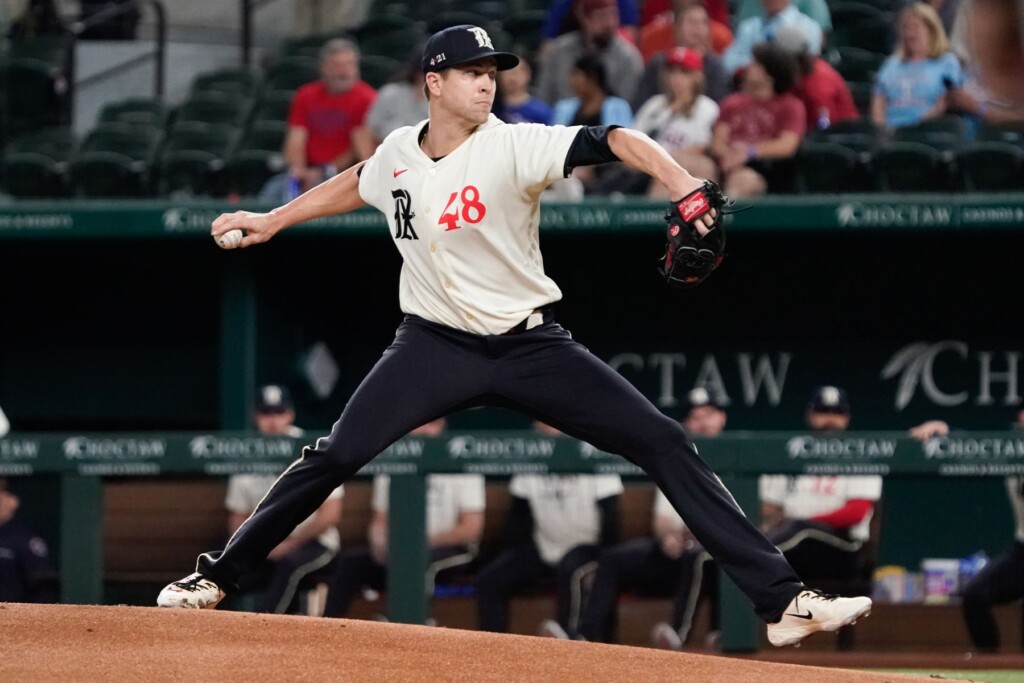Pitchers and catchers are ready to report to spring training, which means it’s time for the offseason’s last formal ritual: deciding who won on paper. Websites like FanGraphs, Baseball Prospectus, and The Athletic are offering their preseason projections of how the standings will shake out—and they’re not flattering for the Texas Rangers. Two systems used at FanGraphs have Texas at just 56 and 34 percent odds to make the playoffs in 2024, while Baseball Prospectus also chimes in at 56 percent.
I know we’re all going to have an emotional gut reaction to the defending champions being lowballed so hard, so let’s get that out of the way before we talk about the very real weakness those numbers highlight.
Bleargh! Humbug! How dare they! A pox on FanGraphs’ houses! They hate us cuz they ain’t us! Neeerrrrrrrrrrrrrrds!
OK. Ready to move on?
Truth is, the 2024 Rangers are taking a calculated risk. Like a load-managed, star-heavy NBA team, the Rangers have assembled a roster that looks much more fearsome in the playoffs than it does in the regular season. By next October, Jacob deGrom, Max Scherzer, and new addition Tyler Mahle will be ready to lead the rotation. That’s a ferocious trio of pitchers to add midseason.
But before those three stars return to the mound, Texas has to win a bunch of games. Right now, the Rangers’ pitching plan for the first half appears to be Nathan Eovaldi, Jon Gray, Josh Sborz, and pray the offense scores eight runs a night. Maybe that’s not fair to handy swingmen like Dane Dunning and Andrew Heaney, or bounce-back candidates like Jonathan Hernández, but it sure looks like for Texas, Plan B has become Plan A.
The signing of Mahle, especially, signaled that Texas’ strategy simply assumes it will be right in the middle of a playoff chase in high summer. Mahle was a stud for the Minnesota Twins—until he underwent Tommy John surgery on May 22, 2023. The Rangers signed him to a two-year, $22 million contract knowing he will likely not appear on the majors until early July. They also know Scherzer is expected back in July after repairs to a herniated disc, while deGrom is looking at an August return from his second bout with Tommy John.
But here’s the thing: July and August are in the second half of the season. In the meantime, Texas will need to get through 80 or so games with only two members of its ideal starting five. That means plenty of opportunities for Cody Bradford and Owen White to prove they can go six innings—and for injury comeback guys like Hernández and Kirby Yates to prove they can relieve them.
In an ordinary season, that might be fine. But we’re talking about the defending champions here. The Rangers have reached the promised land and held a parade—and now they’re back to wondering if someone like Brock Burke can rebound to his 2022 form. We’re not just talking about an individual player’s performance regressing; we’re talking about the whole organization being at risk of regression to the 1990s, when the Rangers hovered around .500 every year and bopped into the ALDS every once in a while. Back then, the plan was to both score and allow buckets of runs. The 1998 Rangers gave 86 starts to guys with ERAs over 5.00, and they still won the division.
So, for the first half of 2024, the plan appears to be winning every game 8-7. The offense that put on a month-long fireworks show last October will be back to get on base and sock home runs. But Scherzer won’t be, and if Jordan Montgomery isn’t tempted by a lifetime supply of free barbecue, he won’t be, either.
The biggest bullpen move the Rangers have made is swapping out wild man Aroldis Chapman for the slightly more reliable, significantly older David Robertson. That gives Bruce Bochy, by my count, three trusted relievers (Sborz, Robertson, and José Leclerc), three hmm-maybe guys (Burke, Hernández, and Yates), some unexciting innings munchers (Grant Anderson, Josh Stephan, Chase Lee), and one potential power reliever who, like most of the starting rotation, is recovering from Tommy John and expected back midsummer (Kumar Rocker). Not ideal. (If you want something to hope on, FanGraphs scouting writer Eric Longenhagen thinks Antoine Kelly is a potential Chapman 2.0: “It will probably be tough to trust him in high-leverage spots because he’s so wild, but Kelly is going to be a really nasty lefty middle-inning option.”)
In the playoffs, you really only need four or five good relievers to get by, and one of them can be a demoted starter. We learned that last year with Gray’s relief turn, and I learned it in 2019 as a fan of a team that won the World Series in Houston despite allowing 42-year-old Fernando Rodney to pitch in three games.
But—that’s in the playoffs. A season has a lot of innings! Yes, it may be good to spend some time finding out if Lee or Kelly can become “the guys.” But we’re talking about half a season. We’re talking about the defending champions. Hoping Nuke LaLoosh can learn control and become a useful sixth-inning reliever is the kind of behavior you expect of a White Sox fan, not a front office that just finished mopping up the knock-off champagne.
Like I said: Plan B has become Plan A. Unless the Rangers have more free agency moves left—Montgomery is still out there—their strategy is to hope that the pitching they already have in-house holds up for half a season.
Even a hardcore Cody Bradford fan must understand the size of that risk. A calculated risk with a potentially huge payoff, but a big risk nonetheless. The Houston Astros and Seattle Mariners are in a similar exciting-but-flawed tier. They’ll be fighting all the way.
So when you see someone report that the defending champions are a 50-50 shot to even return to the playoffs, remember: that’s the risk the Rangers deliberately took. They sacrificed a significant portion of regular-season innings in exchange for possible playoff wins. If they hit the right side of those odds, the rest of the league is going to be terrified. If they don’t—well, flags fly forever.
Author







